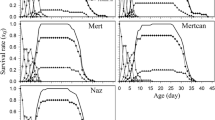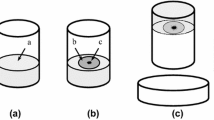Abstract
Green peach aphids, Myzus persicae (Sulz.) (Hemiptera: Aphididae), obtained from pepper fields, were colonized on susceptible pepper plants in a growth chamber. The development, survivorship, and life table parameters of the green peach aphid were evaluated on nine peppers cultivars as follows: Almuden, Bilano, Bird, Cabezo, de la Sierra, Eppo, Jaen, Raza, and Yatasto at controlled conditions (20 ± 1°C; about 70% RH; 14h photophase). The development times of immatures ranged from 6.1 days on Yatasto to 11.4 days on Jaen, whereas immature survival was close to 100% on all cultivars. The intrinsic rate of increase (r m ) for green peach aphid on Bilano and Yatasto were the highest. Jackknife estimates of r m varied from 0.281 to 0.174 females/female/day on Yatasto and Jaen, respectively. The mean population generation times (T) on these hosts ranged from 13.7 to 22.7 days. The highest net reproductive rates (R 0 ) were on Bird and Bilano (63.8 and 62.89 females/female/generation, respectively) and the lowest on De la Sierra and Almuden (34.1 and 38.7, respectively). Because of the high coefficient of determination (R 2) values in Gompertz and Weibul models, survival data from different cultivars had a good fit to both models. The results pointed Jaen, Almuden, and Raza cultivars as the least suitable host plants, indicating that they were the most resistant to M. persicae among the cultivars we tested.

Similar content being viewed by others

References
Birch LC (1948) The intrinsic rate of natural increase of an insect population. J Anim Ecol 17:15–26
Blackman RL, Eastop VF (2007) In: van Emden H, Harrington R (eds) Taxonomic Issues In Aphids As Crop Pests. CABI Publishing, Wallingford, p 752
Carey JR (2001) Insect biodemography. Ann Rev Entomol 46:79–110
Deevey ES (1947) Life tables for natural populations of animals. Q Rev Biol 22:283–314
Dent D (2000) Host plant resistance. In: Dent D (ed) Insect pest management, 2nd edn. CABI Publishing, Wallingford, p 410
Dhingra OD, Sinclair JB (1985) Basic plant pathology methods. CRC Press, Boca Ratón, Florida, USA, 439 pp
Diaz BM, Fereres A (2005) Life table and population parameters of Nasonovia ribisnigri (Homoptera: Aphididae) at different constant temperatures. Environ Entomol 34(3):527–534
Dixon AFG (1987) Parthenogenetic reproduction and the rate of increase in aphids. In: Minks AK, Harrewijn P (eds) Aphids their biology, natural enemies and control, vol. A. Elsevier, Amsterdam, The Netherlands, p 450
Elliott AC, Hynan LS (2011) A SAS(®) macro implementation of a multiple comparison post hoc test for a Kruskal–Wallis analysis. Comput Methods Prog Biomed 102(1):75–80
Gotelli NJ (1998) A primer of Ecology. Sinauer Associates Inc, Sunderland, p 236
Guldemond JA, van den Brink WJ, den Belder E (1998) Methods of assessing population increase in aphids and the effect of growth stage of the host plant on population growth rates. Entomol Exp Appl 86:163–173
Gutierrez APD, Morgan J, Havenstein DE (1971) The ecology of Aphis craccivora Koch and subterranean clover stunt Virus. I. The phenology of aphid populations and the epidemiology of virus in pastures in South-East Australia. J Appl Ecol 8:699–7210
Jackai LE, Gaudon C, Asiwe JA, Tayo BO (2001) Integrated control of the cowpea aphid using seed dressing and varietal resistance. Samaru J Agric Res 17:13–23
Kennedy GG, Abou-Ghadir MF (1979) Bionomics of the turnip aphid on two turnip cultivars. J Econ Entomol 72:754–757
La Rossa FR, Kahn N (2003) Dos programas de computadora para confeccionar tablas de vida de fertilidad y calcular parámetros biológicos y demográficos en áfidos (Homoptera: Aphidoidea). Rev Investig Agropecuarias (INTA) 32(3):127–142
Laamari M, Khelfa L, Cœur d’ Acier A (2008) Resistance source to cowpea aphid (Aphis craccivora Koch) in broad bean (Vicia faba L.) Algerian landrace collection. Afr J Biotechnol 7:2486–2490
Maia AHN, Luiz AJB, Campanhola C (2000) Statistical inference on associated fertility life table parameters using jackknife technique: computational aspects. J Econ Entomol 93:511–518
Marco S (1993) Incidence of non-persistently transmitted viruses in pepper sprayed with whitewash, oil, and insecticide, alone or combined. Plant Dis 97:1119–1122
Meyer JS, Ingersoli CG, Mc Donalds LL, Boyce MS (1986) Estimating uncertainty in population growth rates: Jackknife versus Bootstrap techniques. Ecology 67:1156–1166
Noble MD (1960) A simplified cage for aphid investigations. Can Entomol 90:760
Obopile M, Ositile M (2010) Life table and population parameters of cowpea aphid, Aphis craccivora Koch (Homoptera: Aphididae) on five cowpea Vigna unguiculata (L. Walp.) varieties. J Pestic Sci 83:9–14
Ohta I, Ohtaishi M (2002) Life-history parameters of Myzus persicae (Sulzer) (Homoptera: Aphididae) reared on Qing-geng-cai at four constant temperatures. Jpn J Appl Entomol Zool 46:259–261
Pinder JE III, Wiener JG, Smith MH (1978) The Weibull distribution: a new method of summarizing survivorship data. Ecology 59:175–179
Polack A, Saini E, Garcia Sampedro C (2002) Guía de monitoreo y reconocimiento de plagas y enemigos naturales de tomate y pimiento. Ediciones INTA, EEA San Pedro, 51 pp
Quiroz C, Larraín P, Sepúlveda P (2005) Abundancia estacional de insectos vectores de virosis en dos ecosistemas de pimiento (Capsicum annuum L.) de la Región de Coquimbo, Chile. Agricultura Técnica 65(1):3–19
Razmjou J, Moharramipour S, Fathipour Y, Mirhoseini SZ (2006) Effect of cotton cultivar on performance of Aphis gossypii (Homoptera: Aphididae) in Iran. J Econ Entomol 99:1820–1825
Ricci M, La Rossa FR, Vasicek A (2000) Demografía del “pulgón verde del duraznero” Myzus persicae (Sulzer) (Homoptera: Aphidoidea) sobre pimiento (Capsicum annuum) en condiciones de laboratorio. Rev CEIBA Honduras 41(1):17–20
Richard OW (1961) The theoretical and practical study of natural insect populations. Ann Rev Entomol 6:147–162
Ruggle P, Gutierrez AP (1995) Use of life tables to assess host plant resistance in alfalfa to Therioaphis trifolii f. maculata (Homoptera: Aphididae): hypothesis for maintenance of resistance. Environ Entomol 24:313–325
Sarfraz M, Dosdall LM, Keddie BA (2006) Diamondback moth-host plant interactions: implications for pest management. Crop Prot 25:625–639
SAS Institute Inc. (2002) Help and Documentation, Cary, NC. USA
Sokal RR, Rohlf FJ (1995) Biometry, 3rd ed. W.H. Freeman, New York. USA. 887 pp
Soroka JJ, Holowachuk JM, Gruber MY, Grenkow LF (2011) Feeding by flea beetles (Coleoptera: Chrysomelidae; Phyllotreta spp.) is decreased on canola (Brassica napus) seedlings with increased trichome density. J Econ Entomol 104(1):125–136
Southwood RRE, Henderson PA (2000) Ecological Methods, 3rd edn. Blackwell Science, Oxford, 575 pp
SPSS Inc. (2006) SPSS Base 15.0 for Windows User’s Guide. SPSS Inc., Chicago IL. USA
Tremblay E, Souliotis C (1974) Saggio su un Índice bioclimatico per il Myzus persicae Sulz. (Homoptera: Aphidoidea). Bollettino del Laboratorio di Entomologia Agricola. “Filippo Silvestri” 31: 109–120
van Lenteren JC, Noldus LP (1990) Whitefly-plant relationships: behavioral and ecological aspects. In D. Gerling (ed.). Whiteflies: their bionomics, pest status and management. Intercept. The Netherlands. 348 pp
Vasicek A, La Rossa FR, Mendy M, López M, Paglioni A (2006) Respuesta biológica poblacional de Myzus persicae (Sulz.) (Homoptera: Aphididae) sobre seis cultivares de pimiento (Capsicum annuum L.) en condiciones de laboratorio. Bol Sanid Veg 32:499–505, Plagas
Author information
Authors and Affiliations
Corresponding author
Additional information
Edited by André L Lourenção – IAC
Rights and permissions
About this article
Cite this article
La Rossa, F.R., Vasicek, A. & López, M.C. Effects of Pepper (Capsicum annuum) Cultivars on the Biology and Life Table Parameters of Myzus persicae (Sulz.) (Hemiptera: Aphididae). Neotrop Entomol 42, 634–641 (2013). https://doi.org/10.1007/s13744-013-0166-9
Received:
Accepted:
Published:
Issue Date:
DOI: https://doi.org/10.1007/s13744-013-0166-9



